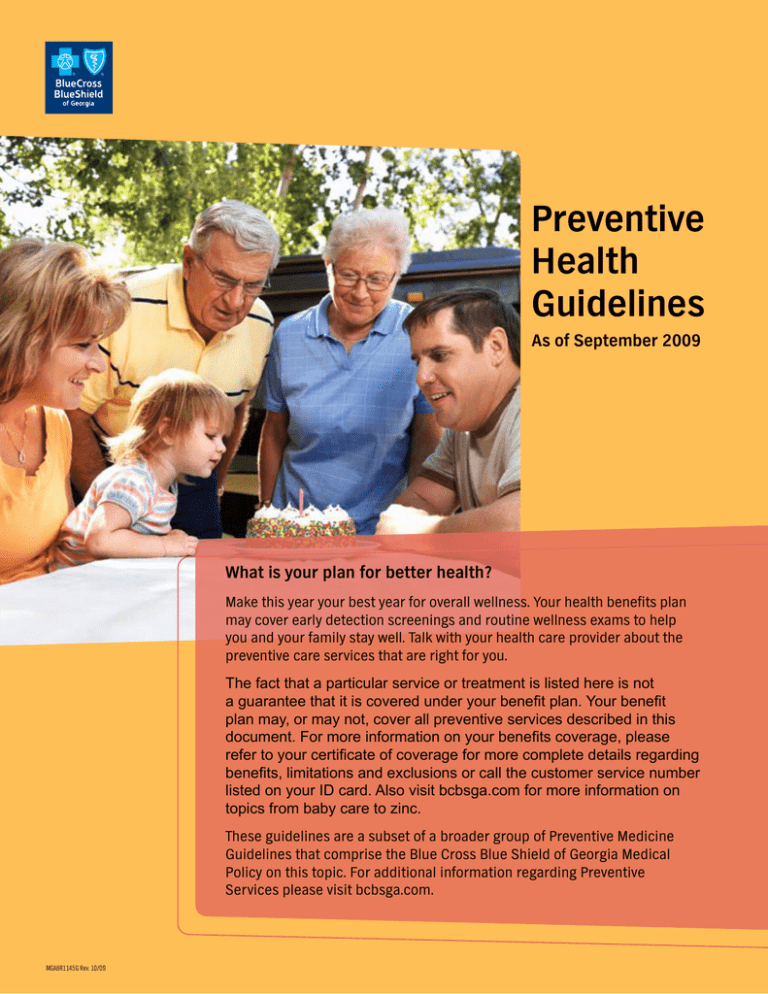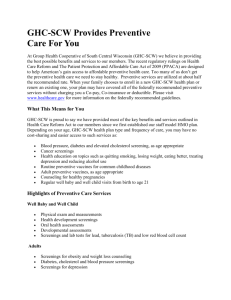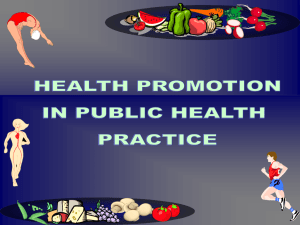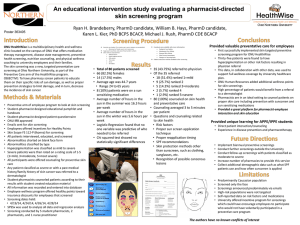Preventive Health Guidelines As of September 2009
advertisement

Preventive Health Guidelines As of September 2009 What is your plan for better health? Make this year your best year for overall wellness. Your health benefits plan may cover early detection screenings and routine wellness exams to help you and your family stay well. Talk with your health care provider about the preventive care services that are right for you. The fact that a particular service or treatment is listed here is not a guarantee that it is covered under your benefit plan. Your benefit plan may, or may not, cover all preventive services described in this document. For more information on your benefits coverage, please refer to your certificate of coverage for more complete details regarding benefits, limitations and exclusions or call the customer service number listed on your ID card. Also visit bcbsga.com for more information on topics from baby care to zinc. These guidelines are a subset of a broader group of Preventive Medicine Guidelines that comprise the Blue Cross Blue Shield of Georgia Medical Policy on this topic. For additional information regarding Preventive Services please visit bcbsga.com. MGABR1145G Rev. 10/09 These preventive health guidelines are based on recommendations of independent national health care organizations, including: AAFP: American Academy of Family Physicians }} AAP: American Academy of Pediatrics }} ACIP: Advisory Committee on Immunization Practices }} ACOG: American College of Obstetrics and Gynecology }} ACS: American Cancer Society }} ATP III/NCEP: Adult Treatment Panel III / National Cholesterol Education Program }} CDC: Center for Disease Control and Prevention }} USPSTF: U.S. Preventive Services Task Force }} These guidelines are only a general guide intended for educational purposes. Be sure to schedule regular exams with your doctor for you and your children, using these recommendations as a guide. Ask your doctor which exams, tests and immunizations are right for you, when you should receive them and how often. Factors that can place persons at risk for certain diseases are not discussed in these guidelines. Please refer to your benefits materials for specific coverage information. Child screenings WELL BABY — Birth to 2 Years** WELL CHILD — Ages 11 to 18** Well-baby exam: birth, 1, 2, 4, 6, 9, 12, 15, 18, and 24 months. Infants discharged less than 48 hours after delivery need a visit 2 to 4 days after birth. In addition, a visit with a pediatrician before the baby is born is recommended for first-time parents, those with high-risk pregnancies and those who want to learn about feeding, circumcision and well-baby care. During the well-baby exam you may receive advice about your child’s safety, health, nutrition and development. These exams may also include immunizations and the following screenings: Well-child exam: once a year. Well-child exams may include immunizations, discussions on health and wellness issues (nutrition, physical activity, healthy weight, injury prevention, avoidance of tobacco, alcohol and drugs, sexual behavior, dental health, mental health and second hand smoke) and the following screenings: Blood pressure }} Vision and hearing: at ages 12, 15 and 18 or as your child’s health care provider advises }} Height, weight and BMI percentile-for-age Hearing as a newborn and as your child’s health care provider advises }} Weight, length and head circumference }} }} }} Chlamydia screening for sexually active females under 25 }} Age-appropriate developmental/behavioral assessments Hemoglobin or hematocrit: once between 9 and 12 months }} Lead testing at ages 1 and 2 years unless lead exposure can be confidently excluded }} Age-appropriate developmental/behavioral assessments }} WELL CHILD — Ages 3 to 10** Well-child exam: at age 30 months and then once a year for children ages 3 to 10. You may receive advice about your child’s safety, injury prevention, health, nutrition and development. Well-child exams may include immunizations and the following screenings: Blood pressure }} Vision screening }} Hearing }} Height, weight and Body Mass Index (BMI)* percentile-for-age }} Age-appropriate developmental/behavioral assessments }} *BMI: Height and weight is used to calculate BMI. BMI for children is gender and age specific and is used to assess underweight, overweight and risk for overweight. BMI for adults is used to assess whether a person is overweight and obese. **These Preventive Health Guidelines reflect recommendations for individuals of average risk. Individuals who are higher-risk, including but not limited to those in certain racial/ethnic groups or with personal/family medical history, should check with his/her health care provider for preventive health guidance. Adult screenings ADULT — Ages 19 to 39** Well-person exam: At this exam you may receive immunizations, counseling on health and wellness issues, (nutrition including discussion of folic acid supplementation for women of child bearing age, family planning, physical activity, injury prevention, misuse of drugs and alcohol, tobacco cessation, sexual behavior, dental health, mental health) and the following screenings: Blood pressure }} Height, weight and BMI }} Cholesterol every 5 years beginning at age 20 }} Women Breast cancer: Self breast exam every month; clinical breast exam by your health care provider every 2 to 3 years }} Cervical cancer: Annually beginning within 3 years of sexual activity or age 21 (whichever comes first). Every 2 to 3 years for women ages 30 and older with 3 normal Pap tests in a row }} Chlamydia: sexually active women ages 25 and under }} Women Breast cancer: Self breast exam every month; clinical breast exam by your health care provider and mammogram every year }} Cervical cancer: Every 2 to 3 years for women with 3 normal Pap tests in a row }} Men Prostate cancer: 50 and older discuss risk and benefits of prostate cancer screening with your health care provider }} ADULT — Ages 65 and older** Well-person exam: At this exam you may receive immunizations, counseling on health and wellness issues (nutrition, physical activity, injury prevention, alcohol misuse, tobacco cessation, second hand smoke, sexual behavior, mental health) and the following screenings: Blood pressure }} Height, weight and BMI }} Cholesterol: Continued screening per health care provider }} ADULT — Ages 40 to 64** Well-person exam: At this exam you may receive immunizations, counseling on health and wellness issues (nutrition, exercise, injury prevention, misuse of drugs and alcohol, tobacco cessation, sexual behavior, dental health, mental health) and the following screenings: Blood pressure }} Height, weight and BMI }} Cholesterol: Continued screening per health care provider }} Colorectal cancer: Beginning at age 50, screening recommendations include 1 of these 6 testing options: }} —— Fecal Occult Blood Test (FOBT) each year —— Flexible sigmoidoscopy every 5 years —— Fecal Occult Blood Test (FOBT) each year, plus flexible sigmoidoscopy every 5 years —— Double-contrast barium enema every 5 years —— Colonoscopy every 10 years —— CT colonography may be an appropriate alternative to colonoscopy Colorectal cancer: Beginning at age 50, screening recommendations include 1 of these 6 testing options: }} —— Fecal Occult Blood Test (FOBT) each year —— Flexible sigmoidoscopy every 5 years —— Fecal Occult Blood Test (FOBT) each year, plus flexible sigmoidoscopy every 5 years —— Double-contrast barium enema every 5 years —— Colonoscopy every 10 years —— CT colonography may be an appropriate alternative to colonoscopy }}Hearing: as your health care provider recommends Women Breast cancer: Self breast exam every month; clinical breast exam by your health care provider and mammogram every year }} **These Preventive Health Guidelines reflect recommendations for individuals of average risk. Individuals who are higher-risk, including but not limited to those in certain racial/ethnic groups or with personal/ family medical history, should check with his/her health care provider for preventive health guidance. Cervical cancer: Every 2 to 3 years for women with 3 normal Pap tests in a row. Women 70 years of age or older who have had 3 or more normal Pap tests in a row and no abnormal Pap test results in the last 10 years may choose to stop having cervical cancer screening }} Osteoporosis: Women at menopause should discuss the risks and benefits of screening with their health care provider. Bone density testing should begin no later than age 65. Earlier screening may be appropriate for some women }} Men Other tests and screenings: Several tests either alone or in combination can be used to assess the fetus for abnormalities. These various tests are done at different times during the pregnancy, and the optimal test depends upon a number of factors including your age, medical history and family history. Discuss with your health care provider what information these tests provide, and the risks of different tests and which, if any, may be best for you. Special blood tests }} Ultrasound tests including special testing (used with blood tests during the first trimester for chromosomal abnormality risk) and routine two dimensional tests for fetal assessment }} Abdominal aortic aneurysm: One time for ages 65 to 75 who have ever smoked }} Prostate cancer: 50 and older discuss risk and benefits of prostate cancer screening with your health care provider }} Pregnant Women** Pregnant women should visit their health care provider or OB/ GYN in their first trimester for an initial visit and to establish a prenatal care schedule. During this visit your health care provider will check your health and the health of your baby. Based on your medical history, your health care provider may recommend the following tests, screenings and immunizations: Tests, education and screenings recommended for all pregnant women at their first prenatal visit: Hematocrit/Hemoglobin }} Syphilis }} Amniocentesis }} Chorionic Villus Sampling }} Immunizations: It is recommended that women who will be pregnant during flu season (October to March) have the inactivated seasonal influenza vaccine. Also, the Tetanus-diphtheriaPertussis (Tdap) vaccine is advised if it was not previously received. While other vaccines may be appropriate in special circumstances, it is generally recommended to get needed vaccines before becoming pregnant. Women should always check with their health care provider to discuss special circumstances and needs. Two vaccines, Measles-Mumps-Rubella (MMR) and Varicella, should NOT be given during pregnancy. HIV }} Rubella immunity to identify women needing rubella vaccine after giving birth }} Rh(D) blood type and antibody testing. If Rh(D) negative, repeat testing at 26 to 28 weeks }} Hepatitis B }} Urinalysis as your health care provider advises }} Education regarding diet and activity during pregnancy }} Education and counseling regarding tobacco and other substance avoidance }} **These Preventive Health Guidelines reflect recommendations for individuals of average risk. Individuals who are higher-risk, including but not limited to those in certain racial/ethnic groups or with personal/ family medical history, should check with his/her health care provider for preventive health guidance. Recommended Immunization Schedule** Age Vaccine Birth Hepatitis B 4 1-2 2 4 6 months months months months 4 See footnote 1 6-18 months 4 12-15 months 15-18 months 24 months 4-6 years 11-12 years 13-18 years 19-49 years 50-64 years 65+ years Rotavirus (RV) 4 2-3 dose series* Diphtheria-Tetanus- Pertussis (DTaP) 4 4 4 4 4 Tetanus-diphtheria- Pertussis (Td/Tdap) Haemophilus influenza type b (Hib) 4 4 4 4 Pneumococcal (PCV) 4 4 4 4 Inactivated polio virus (IPV) 4 4 4 4 4 TdapTd booster every10 years 4 Influenza (seasonal flu) Recommended annually from 6 months to 18 years of age Measles, Mumps, Rubella (MMR) 4 4 Varicella (chicken pox) 4 4 Hepatitis A 4 2 dose series Recommended annually from 50-65+ years of age Human Papillomavirus (HPV) 43 dose series Meningococcal (MCV) 4 Pneumococcal (PPSV) 4 ***Recommended for smokers Zoster 1 Only if combination vaccine used after the birth dose Tdap (adolescent) — If not previously vaccinated, those 13-18 years of age, discuss catch-up vaccination with your doctor. Td (adults) — If not previously vaccinated with Tdap, substitute one single dose of Tdap for Td. Influenza, new or updated vaccines — Refer to www.flu.gov or www.cdc.gov for updated vaccine recommendations. NOTE: For final CDC recommendations regarding the H1N1 vaccine, please refer to www.flu.gov or www.cdc.gov. Measles, Mumps, Rubella (MMR) and Varicella — Those ages 19 and older who lack evidence of immunity (e.g., lack of documentation of vaccination or have no evidence of prior infection) should be vaccinated. HPV — While vaccination with HPV is recommended for girls ages 11-12 years, it may be given as early as 9 years. For girls and women age 13-26 years who have not been previously vaccinated, discuss catch-up vaccination with your doctor. Meningococcal vaccine (MCV) — If not previously vaccinated at 11-12 years of age, routine vaccination is recommended for 13-18 years of age and college freshman living in dormitories. 4 one lifetime dose 4 one single dose for age ≥60 4 indicates when immunizations are recommended * Rotavirus — 2 to 3 dose series depending on brand of vaccine used **These Preventive Health Guidelines reflect recommendations for individuals of average risk. Individuals who are higher-risk, including but not limited to those in certain racial/ethnic groups or with personal/family medical history, should check with his/her health care provider for preventive health guidance. ***Pneumococcal (PPSV) for smokers — Give 1 dose if unvaccinated or if previous vaccination history is unknown. **These Preventive Health Guidelines reflect recommendations for individuals of average risk. Individuals who are higher-risk, including but not limited to those in certain racial/ethnic groups or with personal/family medical history, should check with his/her health care provider for preventive health guidance. For more information, please visit bcbsga.com For additional information on immunizations, please visit the Centers for Disease Control and Prevention (CDC) website: www.cdc.gov Blue Cross and Blue Shield of Georgia, Inc., is an independent licensee of the Blue Cross and Blue Shield Association. The Blue Cross and Blue Shield names and symbols are registered marks of the Blue Cross and Blue Shield Association.


